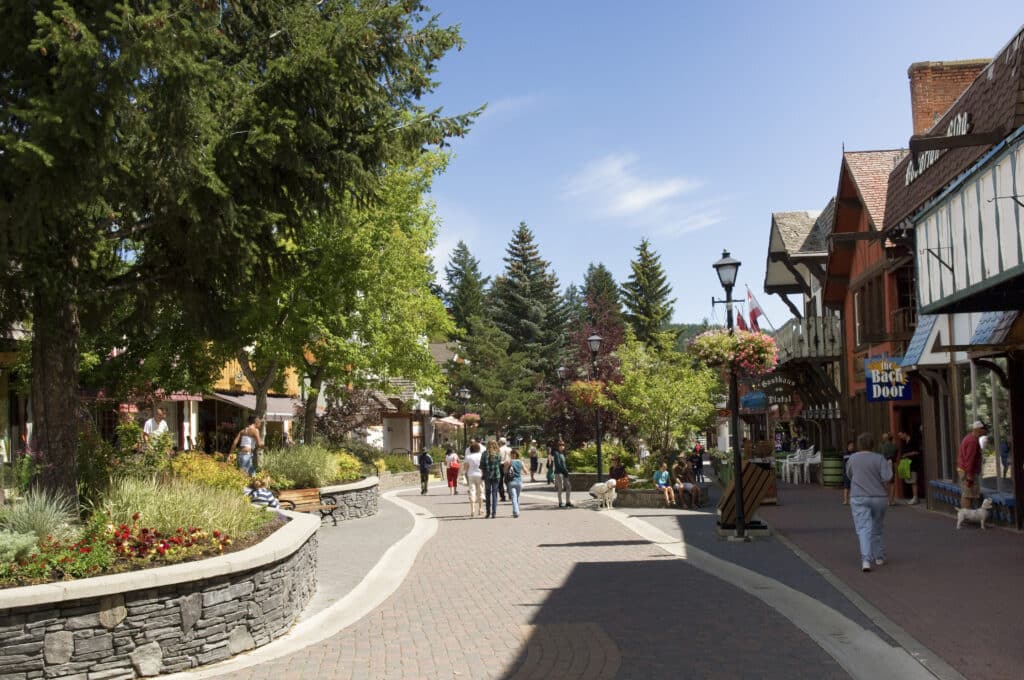Active Transportation describes all human-powered forms of travel, such as walking, cycling, in-line skating, skateboarding, skiing, canoeing, and more. Walking and cycling are among the most popular and can be combined with other modes, such as public transit.i Some examples are walking to the store or to school, or cycling to the recreation centre.
In recent years, Canadians have become less and less physically active, and this is a public health concern.ii Active transportation is a key way for more people to be consistently active in their daily lives, improving their health. Evidence shows that residents choose active transportation where there is infrastructure for active transportation (e.g., sidewalks, bike lanes) and where destinations are close together.
According to the Federation of Canadian Municipalities, “People are quick to agree that active transportation is vital to sustainable, healthy communities. It’s easy to see why—when people walk and cycle, they create desirable communities with less traffic, livelier streets and cleaner air.”iii
What is this issue about?
Regional and local governments invest a big proportion of their budgets in transportation networks and infrastructure. Investments in active transportation infrastructure yield positive health outcomes for the benefiting residents. Active transportation is one of the most cost-effective ways for an individual to become more physically active and remain healthy in the long-term. If all Canadians engaged in 60 minutes of physical activity per day, 33% of all deaths related to coronary heart disease, 25% of deaths related to stroke, 20% of deaths related to Type 2 diabetes, and 20% of deaths related to hypertension could be avoided.iv
Active transportation infrastructure yields many additional community benefits:
- efficient transportation
- improved air quality (due to less vehicle travel)
- reduced contributions to climate change (due to lower GHG emissions)
- improved vibrancy and livabilityv (due to mixed use and compact land use as well as many people being “out and about” in the community)
Evidence shows that people choose an active mode of transportation for utilitarian trips if it is time efficient, safe, and pleasant—in both perception and in reality.vi Reasons that people give for not walking or cycling usually involve poor weather, safety concerns, a lack of sidewalks and cycling facilities, time pressures, and lack of secure bicycle parking. Local governments have a crucial role and expertise with design and land use strategies to overcome these challenges.
Key factors that tip people’s choices toward active transportation modes are:
- Transportation planning and design: street networks that efficiently connect trip origins and destinations, including a street grid pattern, and safe infrastructure such as vehicle-separated pedestrian and bike routes and safe crossings.
- Community land use and design: short distances for daily trips, which occur in areas with higher building density and greater mix of land uses.
Why is active transportation important for health and well-being?
Daily Habits Yield Long-Term Physical Health Benefits
Brisk walking or cycling for daily trips, such as cycling to the store, yields similar health benefits to a structured exercise like running or going to the gym. Daily habits are most likely to be continued over the long term for accrued health benefits.vii
Active adults have lower rates of obesity (35% lower risk of unhealthy weight by populationviii and lower rates of chronic disease. People with the best access to a variety of built and natural facilities are 43% more likely to be active 30 minutes on most days than those with poor access.ix
Benefits for All Ages
Safe routes to school increase the number of children walking and cycling,[vii] and these learned active transportation skills, habits, and values last a lifetime. For aging adults, active transportation is a key ingredient in independent living, essential for promoting physical health and reducing ailments that weigh on the health care system. Walkable communities also help older people to be socially connected and mentally healthy, which are states associated with longevity.xi The proportion of older adults will increase significantly in coming years.xii
Significant Benefits for Vulnerable Population Groups
The most vulnerable people in society have the most to gain from public investment in walkability:
- For every one dollar spent, three dollars in health benefits will be gained.xiii
- People who are not drivers (e.g., children, people with lower incomes, people with disabilities, and the elderly) can face challenges with accessing jobs, schools, health care, and community facilities. Active transportation networks increase their mobility and access within the community.xiv
- Communities that are well served by public transportation are more affordable than communities where people need to drive more frequently.xv
Safety and Injury Prevention
Safe conditions and infrastructure are key factors in not only preventing injuries and accidents, but also in influencing decisions to walk or cycle.
- In many types of community settings, safety concerns keep one in five Canadians from walking or cycling.[xiii] Safe design of streets, using traffic calming and separated bike lanes, for example, are essential to encouraging active transportation choices and preventing injuries and accidents.[xiv] 82% of Canadians are willing to walk more if there is better infrastructure. xviii
- Design for active transportation must pay attention to the context. In Northern BC, for example, where residents are challenged with long distances between amenities and communities, animals on the roads, and inclement weather, motor vehicle crashes are a leading cause of death.xix
Why does active transportation matter for local governments?
Regional and local governments play a significant role in active transportation by developing community transportation plans and policies, as well as designing and implementing transportation networks[xvii] and infrastructure on the ground. These investments are justified by multiple community considerations and benefits: sustainability, health, economy, and crime reduction.xxi Community land use policies and regulations dictate community location, layout, and design to make active modes of transport efficient and pleasant. Local governments have an important regulatory, planning and engagement role in promoting active transportation opportunities for residents.




